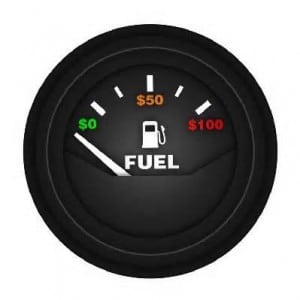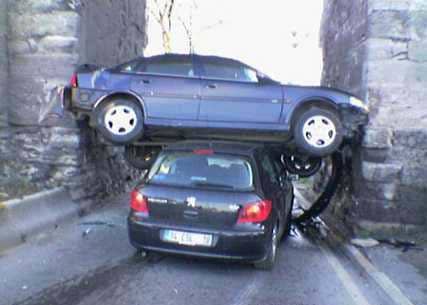by California Casualty | Auto Insurance Info |

As Americans hit the roads for the summer driving season, your vacation trip can be less expensive if you maintain your vehicle for the best gas mileage. Here are six tips from Carcare.org on increasing the miles you get from each gallon of fuel:
- Tune up – properly tuned vehicles can improve gas mileage by an average of 4 percent
- Tire Pressure – proper inflation can net a 3 percent gas mileage improvement
- Motor Oil – get a 1 or 2 percent increase in mileage by using the grade of motor oil recommended by the manufacturer
- Air Filters – replacing clogged filters adds mileage and improves auto performance
- Gas Cap – damaged or missing caps allow fuel to vaporize
- Fix It – getting a serious maintenance problem like a faulty oxygen sensor fixed can improve mileage by as much as 40 percent
The U.S. Department of Energy also has an entire webpage filled with tips on driving more economically and estimating the gas mileage of every vehicle on the road.

by California Casualty | Auto Insurance Info |
There could be a big liability problem with the growing trend of “Ride-Sharing.”
The Property Casualty Insurers Association of America (PCI) reminds people that personal auto insurance policies will not provide coverage if a car is used in a ride-sharing program, otherwise known as transportation network companies (TNCs).
NBC Today reports that thirteen states and the District of Columbia are issuing warnings to passengers that they may not be covered by insurance if a hired ride-sharing driver has an accident. The report also talks to two men stuck with medical bills after a crash in a ride-sharing vehicle.
Ride-sharing is a new transportation trend in major cities around the country where a company uses a smartphone app to connect drivers with people needing a ride for a fee as part of an organized program. “Insurers support innovative ideas, however the drivers and passengers that ride in these cars must know where they stand regarding insurance coverage, said Kelly Campbell, PCI vice president. “Personal auto insurance policies are not intended for commercial activities and contain a specific ‘livery’ exclusion which bars coverage if the car is used to transport passengers for a fee. These exclusions have been upheld in the courts for decades.”
In other words, there may be a coverage gap, especially if the driver is involved in a serious crash while working as a TNC employee. Commercial ride-sharing operators need commercial insurance coverage to protect their vehicle, pay for any injuries they sustain and to cover loss of income from an accident.
While a person’s medical and auto insurance might follow them if they use ride-sharing, the driver’s insurance may not pay their medical bills following a crash.
Consumer Reports wrote a recent article warning drivers about the issues incurred with being a part-time taxi driver.
Make sure your auto and home coverage is up-to-date, contact a California Casualty advisor at 1.866-552-3278 or go to www.calcas.com.
California Casualty, provides auto and home insurance to teachers, law enforcement officers, firefighters and nurses. Get a quote at 1.866-552-3278 or www.calcas.com.
by California Casualty | Auto Insurance Info |
It’s time to face the music. Halloween is over, daylight savings has passed, November is here and…
Winter is coming.
It’s time to stock up on Sweaters, crank up the furnace, and last but certainly not least…

Prepare your car for the winter season.
Around here, we’re all about safety preparations. A few simple steps and check-ups could help keep you, your family, and your car safer this winter.
Recommended Winter-Specific Maintenance:
- Check your antifreeze: Antifreeze is essential for your car’s winter protection. Make sure the level is full and that the mixture is close to 50% water and 50% antifreeze.
- Inspect your tires: Winter conditions often result in slick or icy roads. Your tires are your last defense. Make sure you have checked your tread depth. The National Highway Transportation Safety Board says you need at least 2/32″ of depth to be safe. Also, be sure to check tire pressure.
- Replace your wipers & check wiper fluid: Make sure your wipers can handle any snow, water, or sleet that falls on your windshield. Also make sure that you have plenty of windshield washer fluid- as you’ll be using plenty over the winter months. Don’t fill your washer fluid reservoir with anything except washer fluid.
- Stay on top of maintenance procedures: Before winter hits is the perfect time to make sure you’ve taken care of annual maintenance. While car trouble is a bummer ANY time of the year, it can be especially complicated and frustrating in winter conditions. Avoid the stress: Make sure you’ve inspected, checked, or cleaned your car’s:
- Battery and battery posts
- Engine oil
- Brakes and brake fluid
- Spark plug wires
- Radiator
- Ignition
- Emergency Flashers
- Exhaust
- Defroster
This list is a good starting point. To be sure that your car is in the safest-possible working condition before winter hits, take it to your mechanic.
The National Safety Council recommends stocking your car with the following items in case of an emergency:
- A properly inflated spare tire, wheel wrench and tripod-type jack in case of tire issues
- A shovel
- Jumper cables in case of battery issues
- A bag of salt or cat litter for icy or slick road conditions
- A basic tool kit
- Working flashlight and extra batteries
- Reflective triangles and brightly colored or reflective clothing
- Compass
- First aid kit
- Exterior windshield cleaner
- Ice scraper and snow brush
- Wooden stick matches in a waterproof container
- Scissors and string/cord
- Non-perishable, high energy foods like unsalted canned nuts, dried fruits, and hard candy
- Items to keep you warm, such as heavy mittens, blankets, socks, sweatshirts and a hat
Happy Winter! Be safe out there!
by California Casualty | Auto Insurance Info, Homeowners Insurance Info |
In the wake of Hurricane Sandy, many homeowners are dealing with Flooding damages.
We wanted to provide you with some basic Flood Insurance information* so you can be sure you are fully protected:
- Standard homeowners insurance does NOT cover flooding: Your homeowners insurance policy will not cover flooding damage. Only Flood Insurance covers this kind of damage. To learn more about Flood Insurance through California Casualty, click here or scroll down to read more.
- Flood damages are expensive: Just two inches of water could result in more than $7,000 in damages. The higher the water, the higher the costs.
- New Policies take 30 days to kick in: If your home is at any risk of flooding, protect it now. Flood insurance policies take 30 days to take effect.
- Flood insurance offers two types of protection: Flood insurance protects your building and the contents inside of the building. Neither type protects the land they occupy.
- Building Coverage includes:
- The insured building and its foundation
- The electrical and plumbing systems
- Central air conditioning equipment, furnaces, and water heaters
- Refrigerators, cooking stoves, and built-in appliances such as dishwashers
- Permanently installed carpeting over unfinished floors
- Contents coverage includes:
- Clothing, furniture, and electronic equipment
- Curtains
- Portable and window air conditioner units
- Portable microwaves and dishwashers
- Carpeting that is not already included in property coverage
- Clothing washers and dryers
Securing Flood Insurance through California Casualty:
We provide flood insurance through the National Flood Insurance Program to offer you the best rates and service. It was created by Congress in 1968 to help property owners protect themselves financially against flood damages. To learn about the program, click here.
*These represent typical coverages, you should speak with an agent to verify what is and is not covered
by California Casualty | Auto Insurance Info, Safety |
Car accidents happen.
Whether it’s a fender bender or a pileup, your fault or someone else’s, they just happen.

So when we talk about preparedness during National Preparedness Month, car wrecks should be on your list of scenarios for which you are prepared and ready.
Because how you act following a car wreck won’t just affect the Insurance Claims process, it could affect the safety and security of yourself, your property and your identity.
Did you know that sharing some personal information could put you at risk for identity theft following a car accident?
Check out this information from a 2012 National Association of Insurance Commissioners survey:
- Thirty-eight percent of consumers believed they should share their driver’s license number with the other driver — one in six would even allow the other driver to photograph the license as a convenient way to exchange information.
- So what’s the risk? Many retailers accept driver’s license information to verify your identity over the phone. In fact, your license number is the most common way to confirm your identity after Social Security number and date of birth.
- Twenty-five percent of consumers surveyed said they would share their home address.
- So what’s the risk? Actually, your home address gives identity thieves the physical location of your mail or garbage, the first place criminals often look for personal financial information. And, now a stranger knows where you live, possibly putting your personal safety at risk.
- Twenty-nine percent of survey respondents believed they are required to share personal phone numbers. In fact, sharing your phone number is rarely necessary.
To help you take some of the guesswork out of what to share and what to safeguard following an accident, the National Association of Insurance Commissioners released an app for Smartphones called The WreckCheck App.
- It’s free of charge!
- Works for iPhones and Android phones
- Outlines what to do following an accident
- Walks you through process of creating accident reports
- Tells you which pictures to take
- Helps document damage
- Assists in attaining and sharing only necessary information
- Allows you to email completed reports to yourself or Us (your insurance company!)
For more information on how to download or use the WreckCheck App, click here.
by California Casualty | Auto Insurance Info |
When it comes to auto insurance, you probably consider coverage that will pay you back if your car is damaged. What you might not think about is auto insurance covering damages to others if you’re at fault in an accident. If you are determined liable for damage to the others’ property, or even bodily injury, your auto policy should help protect you against financial disaster.
Every state has a required minimum level of insurance for damages you may be liable for in an accident. Many insurance providers tout cheap rates based on the “state minimum” levels. The tough reality is that these minimums have not been reviewed in many years and do not accurately reflect the costs of today’s automobiles.
California Casualty is working to address such issues before there’s a problem.
One of our customers illuminates the issue. She was determined at fault in a multi-car accident. Her property damage liability limit was $25k. During the claim settlement process, we advised her that it was possible her minimum coverage might not cover all the damage – and she might be responsible for the remaining balance. The customer was frantic with worry she’d owe thousands of dollars in additional damages – out of pocket.
Fortunately for her, our claims team was able to settle for an amount that fell within the customer’s coverage limits.
California Casualty is here to help you make the right choices. We’ll help you evaluate your current liability coverage amounts. Hopefully you never find yourself in a situation where you’re liable for significant property damage or bodily injury.
Will you be able to rest easy knowing that the insurance policy you chose has you covered?



